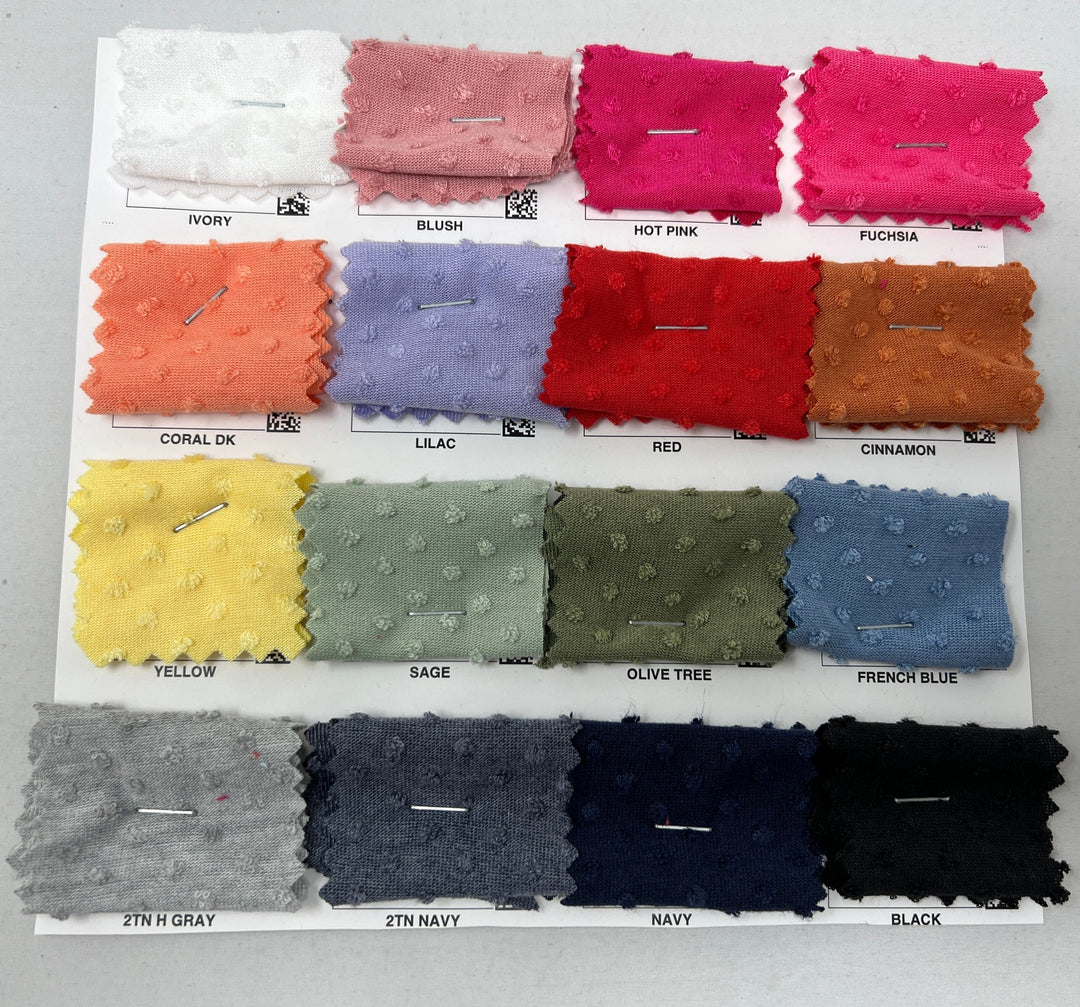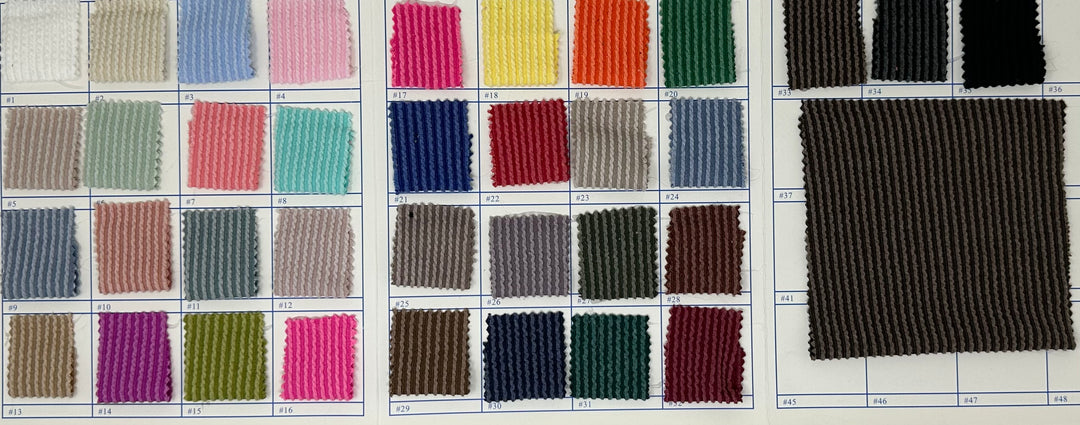The Ultimate Guide of Knits: The Different Types Explained


For those just getting into the world of tailoring or who only like to work with textiles as a casual hobby, the number of fabrics can be overwhelming. The textures, colors, designs, properties, and so much more can vary greatly. You can also customize aspects to fit your project. As a result, it’s easy to become paralyzed with choice. Luckily, you’re not alone in your endeavor. We’ve put together the ultimate guide of knits to present the different types explained. This way, you can experiment with fabrics and use them in your projects.
Cotton Jersey Knit
The cotton jersey knit is often the most common knit you’ll come across. Because it’s soft and fluid, it works well for many garments that we utilize in our day-to-day lives, such as t-shirts. When using jersey knit, though, the most important factor to keep in mind is the weight of the fabric when you’re picking it out. Jersey knit fabrics can vary from lightweight (5 oz.) to heavy (12 oz.), which adds some versatility depending on your preferences or the garments you’re making. On average, most jersey knit fabrics are between 7.5 to 8 oz. This weight strikes a comfortable balance, especially since lightweight jersey knits are prone to becoming stretched out.
Because of how commonly used this knit is, you can be sure you’ll find an expansive range of designs and patterns to choose from for your projects. You should note, though, that while solid color knits will always be nice and soft, the more complicated patterns can cause the prints to become stiff. This is because of the amount of dye necessary to create these patterns, especially with darker colors. You can remedy this stiffness by simply washing the fabric, but it’s helpful to be aware of this quirk when you’re picking out your fabrics.
Cotton Ribbed Knit
The cotton ribbed knit is easy to identify and is aptly named. It has lines, or “ribs,” running up and down the fabric. Compared to the jersey knit, the ribbed knit has more elasticity and is thus favorable for collars and cuffs. Such elasticity also makes it preferable for kids’ clothing, as they can play and express their full range of motion without fear of tearing or stretching out their clothes. This kind of fabric also tends to be very form fitting due to how elastic it is, so keep that in mind for the intended design of your garments.
Cotton Interlock Knit
Another easy-to-find fabric is the cotton interlock knit. While interlock knits typically come in solid colors, there are a few prints you can find if you feel determined for something a bit more inspired. Because the interlock knit is slightly thicker and more stable than some of the other knits, this makes it a fantastic fabric for beginners to use because it’s sewn a lot like a woven fabric. While great for garments, the interlock knit is highly favorable for creating blankets due to its thickness. This quality makes it a bit heavier and better at retaining heat.
Other Cotton Knits
This ultimate guide to knits could explain the different types of cotton knits indefinitely. But we’ll round this category off with a few special mentions before moving on. Cotton thermal knit is what it sounds like and typically makes up long underwear or long-sleeved shirts. The reason for this is that it can retain heat well. Fabrics like modal knits, bamboo knits, silk knits, and hemp knits are all fabrics that use different kinds of natural fibers rather than cotton or polyester. As a result, they’re typically more expensive. There is also the tricot knit that almost always makes up linings. Lightweight tricot knits are perfect for slips, while heavy tricot knits form linings for garments like swimwear or sheer dresses.
French Terry Knit
People consider French terry knit to be luxurious because of its soft and drapey look and feel. At the same time, it has a casual and comfortable feeling because the patterned side is flat, and the underside has tiny loops. These loops are soft to the touch and easy on the skin. So, if you often experience skin irritation from your garments, switching to a French terry knit may be the solution you’re looking for. However, when ordering your fabrics, you should keep in mind that French terry knit tends to shrink in the wash more than other fabrics. So plan accordingly.
Hacci Sweater Knit
As the name suggests, the Hacci sweater knit is incredibly similar to a sweater material. In contrast to a sweater material, though, the Hacci sweater knit is slightly lighter in weight. Manufacturers also sew it just like normal knits. Furthermore, it’s highly soft and elastic, so you don’t have to worry about stretching it out as you might with an average sweater.
Jersey Rayon Spandex
Let's move into the knits that incorporate spandex into their materials. Jersey rayon spandex feels like a nice mix of a jersey and cotton spandex knit that provides the perks of cotton spandex knits but with a much lighter weight. While people typically favor it for kids' clothing, it may be an apt choice for a gathered skirt or dress if you’re looking for a material that’s soft but will help you stay cool in the summer heat.
Bullet Fabric Knit
We highly recommend bullet fabric material because of its pleasing texture on the outside and buttery smoothness on the inside. It has these qualities because it features a combination of polyester and spandex. This makes the fabric comfortable to wear and elastic enough that it’s comfortable to move around in without worrying about stretching the fabric out of its intended shape. It’s also notable that the exterior of this fabric is especially hardy and durable, making it capable of providing structure to your clothing without sacrificing comfort.
Lycra Spandex Knit
Lycra spandex knits are famous for their application in the creation of dancewear and swimwear. Due to their comfortable weight and incredible elasticity, they’re the perfect materials for leotards, leggings, and swimwear. While not great for casual clothing, Lycra spandex knits are essential for people who enjoy sports and other physical activities. It helps them keep themselves comfortable without restricting their full range of motion. Appearance-wise, it’s notable that this material has a smooth and somewhat shiny feel that’s worth considering if you want to get a bit more creative in your garment’s design than using simple solid colors.
















